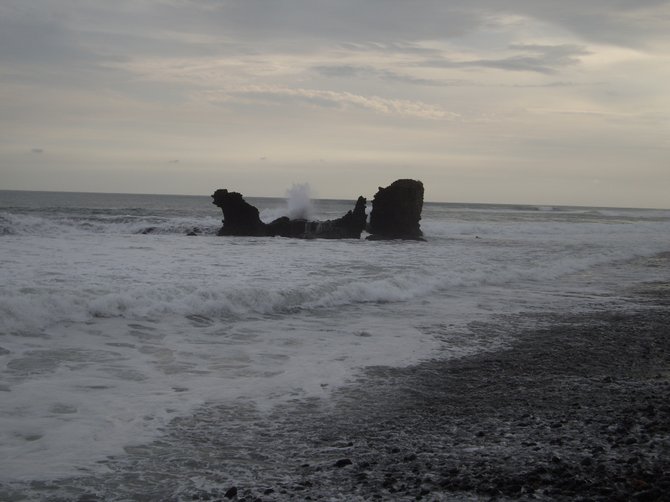 Facebook
Facebook
 X
X
 Instagram
Instagram
 TikTok
TikTok
 Youtube
Youtube

The Balsamo Coast of El Salvador isn’t heaven – but if you surf, it may be the nearest thing here on earth. Plus it’s a whole lot easier to get in.
A four-hour flight from L.A. lands you at the nation’s international airport. From there the Pacific lies less than an hour away. The best-known surf spot is the world-class right break Punta Roca, off the town of La Libertad. Unfortunately, the close proximity of the capital, San Salvador, attracts members of the notorious Mara Salvatrucha 13 (MS-13) gang to the seaside community. It makes the nightlife in this port the most dangerous part of El Salvador.
The highway turns west here, and meanders for approximately 16 miles through several beach hamlets with friendly citizens and excellent surf. We chose Playa El Tunco – a right-angle two-street village – as our base. Small boutique hotels and hostels abound, with prices and amenities ranging from a hammock for $10 to a two-bed, ocean-view, air-conditioned room for $65. The coast is a surprisingly “wired” area, with Wi-Fi in abundance.
Pilsener beer is the local “cerveza mas fina,” and seems to be the only product in the entire country with an advertising budget. When cold, the only thing better than the flavor is the cost – if you paid more than a $1.50 for a bottle, you paid too much. The food is somewhat uninspired, with all sides consisting of beans and rice. But the seafood is excellent and understandably fresh; it’s truly the catch of the day.
As for the waves: Well, Toto, you’re not at La Jolla Shores anymore! The ocean here is a heaving siren, offering warm, uncrowded waters – but with an undertow so strong it is hard to escape its grasp when it’s time to exit.
Adjacent to the breaks at Playa El Tunco, a strong rip current provides a natural channel that, if ridden correctly, makes the quarter- to half-mile paddle out seem much quicker than normal. Here there are three distinct breaks with well-shaped, continuous sets all day.
The waves attract surfers from around the globe. Although the majority had traveled from Australia or Brazil, we met some from the U.K. and even two women of apt ability from the landlocked Czech Republic.
Rental shops offer a plethora of surfboards, making it unnecessary to bring your own unless you’re planning an extended stay.
Catholicism is strong in El Salvador, and its influence is everywhere. Crosses and religious relics appear on buses, cars, buildings and hillsides. The country’s name itself translates to “The Savior.”
As I stated earlier, it’s not heaven; but regardless of your faith or lack thereof, with the nation’s vibrant green fauna, warm caressing breezes and epic swells, it could easily be mistaken for a Garden of Eden.


The Balsamo Coast of El Salvador isn’t heaven – but if you surf, it may be the nearest thing here on earth. Plus it’s a whole lot easier to get in.
A four-hour flight from L.A. lands you at the nation’s international airport. From there the Pacific lies less than an hour away. The best-known surf spot is the world-class right break Punta Roca, off the town of La Libertad. Unfortunately, the close proximity of the capital, San Salvador, attracts members of the notorious Mara Salvatrucha 13 (MS-13) gang to the seaside community. It makes the nightlife in this port the most dangerous part of El Salvador.
The highway turns west here, and meanders for approximately 16 miles through several beach hamlets with friendly citizens and excellent surf. We chose Playa El Tunco – a right-angle two-street village – as our base. Small boutique hotels and hostels abound, with prices and amenities ranging from a hammock for $10 to a two-bed, ocean-view, air-conditioned room for $65. The coast is a surprisingly “wired” area, with Wi-Fi in abundance.
Pilsener beer is the local “cerveza mas fina,” and seems to be the only product in the entire country with an advertising budget. When cold, the only thing better than the flavor is the cost – if you paid more than a $1.50 for a bottle, you paid too much. The food is somewhat uninspired, with all sides consisting of beans and rice. But the seafood is excellent and understandably fresh; it’s truly the catch of the day.
As for the waves: Well, Toto, you’re not at La Jolla Shores anymore! The ocean here is a heaving siren, offering warm, uncrowded waters – but with an undertow so strong it is hard to escape its grasp when it’s time to exit.
Adjacent to the breaks at Playa El Tunco, a strong rip current provides a natural channel that, if ridden correctly, makes the quarter- to half-mile paddle out seem much quicker than normal. Here there are three distinct breaks with well-shaped, continuous sets all day.
The waves attract surfers from around the globe. Although the majority had traveled from Australia or Brazil, we met some from the U.K. and even two women of apt ability from the landlocked Czech Republic.
Rental shops offer a plethora of surfboards, making it unnecessary to bring your own unless you’re planning an extended stay.
Catholicism is strong in El Salvador, and its influence is everywhere. Crosses and religious relics appear on buses, cars, buildings and hillsides. The country’s name itself translates to “The Savior.”
As I stated earlier, it’s not heaven; but regardless of your faith or lack thereof, with the nation’s vibrant green fauna, warm caressing breezes and epic swells, it could easily be mistaken for a Garden of Eden.
Comments